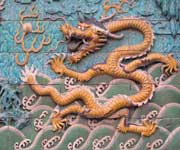The Imperial Palaces bear exceptional testimony to Chinese civilization, being true reserves of landscapes, architecture, furnishings and objects of art, as well as containing exceptional evidence to the living traditions and the customs of shamanism practised by the Manchu people for centuries. They illustrate the grandeur of the imperial institution from the Qing dynasty to the earlier Ming and Yuan dynasties, as well as Manchu traditions, and present evidence on the evolution of this architecture in the 17th and 18th centuries.

Continent: Asia
Country: China
Category: Cultural
Criterion: (I) (II) (III) (IV)
Date of Inscription: 2004
Heritage Imperial Palaces
The Heritage Imperial Palaces is lying at the centre of Beijing to the north of Tiananmen Square; the Forbidden City was the Imperial Palace during the Ming and Qing dynasties. Now known as the Palace Museum, it is rectangular in shape and is the world's largest palace complex, covering 74 ha. The curtain wall has a gate on each side and there are towers at each of the four corners, affording views over both the palace and the city outside.The Forbidden City is an extremely formal place: it is almost symmetrical and hierarchically arranged so that all the important buildings run down the centre, north-south. The Hall of Supreme Harmony, the Hall of Central Harmony and the Hall of Preserving Harmony, which comprise the outer palace where the Emperor exercised his supreme power over the nation, and the Hall of Heavenly Purity, the Hall of Union and the Hall of Earthly Tranquillity, comprising the inner palace where the imperial family lived, stand in a line from south to north on the central axis. In keeping with geomancy, the main gate is in the south and the northern side is 'protected' by the artificial Coal Hill. The buildings of the Forbidden City fully embody the artistic features and style of ancient Chinese palace architecture, and can be called a masterpiece in Chinese, even world, architectural history.
Browse Gallery Plus UNESCO Storyline
In 1406 the Ming dynasty Emperor Zhu Di ordered the construction of an imperial palace: its construction began in 1407 and was completed in 1420. The stone needed was quarried from Fangshan, a suburb of Beijing: for 20,000 peasants to be able to move an enormous stone cylinder in winter, engineers created a huge ice path by pouring liquid water on the frozen soil, and thousands of horses pulled the stone across the ice to the centre of Beijing. Wood was even more difficult to move. Giant trees in Sichuan province were felled for the main halls, but it was found that they were too large to move. Workers had to wait until torrential rains washed the logs into rivers, where boatmen steered them into the Grand Canal, from where they were floated north to Beijing and towed into the palace grounds.
The Imperial Palace of the Qing dynasty in Shenyang consists of 114 buildings; it contains an important library and testifies to the foundation of the last dynasty that ruled China, before it expanded its power to the centre of the country and moved the capital to Beijing. This palace then became auxiliary to the Imperial Palace in Beijing. This remarkable architectural edifice offers important historical testimony to the history of the Qing dynasty and to the cultural traditions of the Manchu and other tribes in the north of China.
Work began on building the palace in 1625 and it was completed in 1636. Although considered to be a miniature of the Forbidden City in Beijing, the Shenyang Palace by comparison is smaller in scale. The Manchurian influence behind its construction also shows a departure in style from its predecessor. The main architecture on the central axis is the Chong Zheng Dian, where the Emperoro attended to his political affairs (this is where Juchen was renamed Manchu). Behind are Feng Huang Lou (Phoenix Tower) and Qing Ning Gong (Palace of Celestial Peace) in which he and his concubines lived. Da Zheng Dian (Hall of Great Affairs) is the main building on the east axis. In front of the hall there are eight pavilions where the Manchurian tribal lords gathered to discuss state affairs and for other important ceremonies.
Browse All UNESCO World Heritage Sites in
China. The original UNESCO inscription
Here!!!











No comments:
Post a Comment